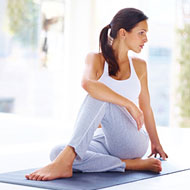- Aromatherapy (36)
- Benefits of Yoga (282)
- Home Remedies (1087)
- massage therapy (9)
- Preventive Therapy (135)
- Running (41)
- Skin Care (15)
- Stress Relief (25)
- Stretching (5)
- walking (33)
- Womens Health (14)
- Yoga Benefits for Pregnant Women (16)
- Yoga Benefits for Students (3)
- Yoga for Children (11)
- Yoga for Holistic Living (37)
- Yoga for Midlife Crisis (3)
- Yoga for Senior Citizens (2)
- Yoga for the Workplace (1)
- Yoga Health Tips (185)
- Yoga Practice during Menstruation (5)
Keep Knees Just Straight to Prevent Knee Lock

A knee lock happens in your body when your knee joint is fully extended. In this extension phase, as the knee moves into full extension the thigh bone or femur rotates inwards slightly on the lower leg bone or tibia and locks the knee joint. When legs are straightened in some people, the tendency to lock the knees is high as they have such joint structures that can promote a hyper-extended position. The legs generally splay backwards mostly in a crescent shape. This hyper-extended position of the knees when they are locked creates a passive stance situation and tends to transfer your body weight on the ligaments, posterior connective tissue and cartilage of the knees. This inner rotation and hyper-extension of the knees also creates a poor body mechanic line and excess rotating movement of the foot. In addition, knee locking can also create unwanted production of anterior pelvic tilt. Knee lock position can also prove useful in certain cases as it can allow you to stand without the use of quadriceps that is used to hold your leg in a straight position. This can create an energy effective mechanism that will allow your knee to stay in extension position for a long period of standing without requiring any muscle contraction.
However this knee locking technique can reduce your benefits of certain standing yoga postures as this act can promote shifting of your lower body progressively engaging muscles in these poses. Thus this ability of hyper-extension of your knee joint can create a passive approach for you in your regular yoga practice to gain less therapeutic benefits. It is better to explore and use your muscles in the lower body part rather then creating a hyper-extension and low energy knee lock. Although a knee lock can make easy to hold a pose, it may put excessive pressure and stress on your knee joint. The main aim in yoga or any other form of exercise is to put pressure on the muscles and not on the joints. Thus as far as possible avoid locking your knees while performing yoga poses. If your knees get locked in a particular standing yoga pose you can unlock them. This can be done by a small muscle known as popliteus situated at the back of your knee joint. When this muscle contracts it will automatically help to unlock your knees and allow your knee joint to flex. Also to prevent your knees to get locked your may keep them slightly bent or just straight.
- RSS Feeds -
- All posts
- All comments
- Exercises for hyperextended knee Whenever the knee flexes in the opposite direction and extends beyond the straig...
- Stretching For Runners Remember those days when your gym coach used to keep telling you to stretch. ...
- Thigh Exercises That Work! As men and women grow older, fat usually begins to get deposited and accumula...
- Exercises For Elderly Regular exercise helps to strengthen the body muscles and allows one to stay ...